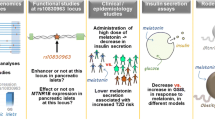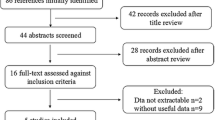Abstract
Aims/hypothesis
Recently, three groups independently reported that variation in MTNR1B, the gene encoding melatonin receptor 1B, was associated with an increased risk of type 2 diabetes, increased fasting plasma glucose and impaired insulin secretion in populations of European ancestry. In the present study, we investigated whether a single MTNR1B polymorphism was associated with type 2 diabetes in Han Chinese individuals, to elucidate whether this is a cross-populational effect.
Methods
The MTNR1B variant rs10830963 was genotyped in 1,165 type 2 diabetic patients and 1,105 normoglycaemic control individuals of southern Han Chinese ancestry who were residents of the metropolitan area of Shanghai. The risk of developing type 2 diabetes was calculated using a logistic regression model adjusted for age, sex and BMI. A possible association with fasting plasma glucose was analysed in the normoglycaemic control individuals using a multiple linear regression analysis with adjustments for age, sex and BMI.
Results
The genetic variant rs10830963 was associated with an increased risk of type 2 diabetes in our Han Chinese cohort (OR 1.16, 95% CI 1.03–1.31, p = 0.015). As previously described, the risk variant was also associated with increased fasting plasma glucose, showing an increase of 0.068 mmol/l (95% CI 0.036–0.100, p = 4 × 10−5) per risk allele.
Conclusions/interpretation
A common variant in the MTNR1B gene is associated with an increased risk of type 2 diabetes and increased fasting plasma glucose in Han Chinese, suggesting an important role for this polymorphism in populations of different ethnic and environmental backgrounds.
Similar content being viewed by others
Introduction
Type 2 diabetes is a multifactorial disease resulting from environmental and behavioural factors in combination with variations in multiple genes. The incidence and prevalence of type 2 diabetes are increasing, no longer only in the Western world, but also in many different ethnic groups worldwide. A recent genome-wide association study (GWAS) has identified a polymorphism (rs10830963) in MTNR1B, which encodes melatonin receptor 1B, which is associated with glucose-stimulated insulin secretion [1]. Furthermore, a meta-analysis of type 2 diabetes GWASs showed a strong association between this single nucleotide polymorphism (SNP) and elevated fasting plasma glucose [2]. The risk MTNR1B genotype also predicted future type 2 diabetes and was associated with impairment of early insulin secretion [3]. Another SNP (rs1387153), located upstream of MTNR1B, has also been associated with increased fasting plasma glucose and risk of type 2 diabetes [4].
Melatonin is mainly produced by the pineal gland but is also released from the gastrointestinal tract [5]. As a highly lipophilic circulating hormone, melatonin easily reaches and penetrates all cells and, in addition to controlling circadian rhythm, it has the ability to neutralise reactive oxygen and nitrogen species and activate the immune system [6]. Several studies have shown a link between disturbances of circadian rhythm and metabolic diseases, including diabetes [7, 8], as well as a clear relationship between insulin and melatonin [9]. Two distinct G protein-coupled receptors, MTNR1A and MTNR1B, mediate the effects of melatonin. These two receptors have been found to be produced in human pancreatic islets [9, 10], and the levels of both are upregulated in type 2 diabetic patients [11]. Furthermore, Lyssenko et al. [3] confirmed the presence of MTNR1B in human pancreatic islets and showed increased MTNR1B mRNA expression in carriers of the rs10830963 risk genotype, reporting a negative correlation between MTNR1B mRNA levels and insulin secretion. Other investigators have shown the expression of MTNR1B mRNA in both islets and sorted beta cells [4]. Taken together, these findings suggest a role for melatonin in the regulation of glucose homeostasis in humans.
Located on chromosome 11q, MTNR1B has only two exons, and the investigated SNP (rs10830963) is found within intron 1. Of 30 SNPs associated with fasting plasma glucose within a 1 Mb region flanking the gene, this SNP produces the strongest association signal [2].
Recent genetic studies of MTNR1B have all been conducted in populations of European ancestry. In the present study, we investigated whether the SNP rs10830963 in MTNR1B is associated with type 2 diabetes and fasting plasma glucose in a Han Chinese cohort.
Methods
Participants
All studied individuals were of southern Han Chinese ancestry and were residing in the metropolitan area of Shanghai. Type 2 diabetic patients (n = 1,165) were recruited from the Endocrinology and Metabolism outpatient clinics at Huashan Hospital in Shanghai, which is affiliated to Fudan University. Type 2 diabetes mellitus was diagnosed according to 1999 WHO criteria [12]. All diabetic patients were unrelated and had been diagnosed after the age of 27 years. Known subtypes of diabetes were excluded based on antibody measurements and inheritance. The 1,105 non-diabetic unrelated control individuals were older than 50 years and had no family history of diabetes mellitus; normal glucose tolerance was verified by an OGTT. The clinical characteristics of the participants are summarised in Table 1. Written informed consent was obtained from all participants and the study was approved by the Ethics Committee of Huashan Hospital.
Genotyping
Genomic DNA was extracted from peripheral blood leucocytes using the conventional phenol/chloroform method. The MTNR1B polymorphism rs10830963 was genotyped using iPLEX (Sequenom, San Diego, CA, USA) and detected by matrix-assisted laser desorption/ionisation time-of-flight mass spectrometry, with a genotyping success rate of 99.1%. The genotype frequencies were in Hardy–Weinberg equilibrium (p all = 0.86; p controls = 0.31), and 96 samples (4%) were run in duplicate with a 100% concordance rate.
Statistical analyses
The OR for the risk of developing type 2 diabetes was calculated using logistic regression, assuming an additive genetic model adjusted for age (age of diagnosis for cases and age at participation for controls), sex and BMI. A multivariate linear regression analysis was used to test the association between the MTNR1B polymorphism and fasting plasma glucose, again adjusted for age, sex and BMI. All statistical analyses were performed using NCSS software, 2004 release (NCSS, Kaysville, UT, USA).
Results
A genetic variant in MTNR1B is associated with an increased risk of type 2 diabetes
The frequency of the earlier reported risk rs10830963 G allele was higher among type 2 diabetes patients than in the control group (44.5% vs 40.9%, p = 0.008). Adjustments for age, sex and BMI yielded an OR of 1.16 (95% CI 1.03–1.31, p = 0.015), assuming an additive model (Table 2).
The MTNR1B variant is associated with fasting plasma glucose in normoglycaemic individuals
The previously reported association with fasting plasma glucose in individuals of European ancestry was replicated in the normoglycaemic controls in our Han Chinese cohort. Carriers of one or two G risk alleles showed a significant increase in fasting plasma glucose, with levels of 5.25 and 5.27 mmol/l, respectively, compared with a mean concentration of 5.15 mmol/l in individuals who were homozygous for the non-risk allele (p = 1 × 10−4 and p = 5 × 10−4, respectively). Using an additive genetic model, this equates to an increase in fasting plasma glucose of 0.068 mmol/l (95% CI 0.036–0.100, p = 4 × 10−5) per risk allele (Table 2).
Discussion
Here we have shown that a common genetic variant in MTNR1B is associated with increases in both fasting plasma glucose and the risk of type 2 diabetes in a Han Chinese cohort. These findings are in line with recently published data in populations of European ancestry [1–4], suggesting that the variant could be of relatively ancient origin. The increase in fasting plasma glucose per risk allele is of the same magnitude as that seen in Europids [2, 3], supporting a similar effect size independent of ancestry. However, the association with type 2 diabetes may have a stronger impact in the Chinese population than in Europids, as Prokopenko et al. [2] only showed a significant association with type 2 diabetes in a very large meta-analysis of 18,236 cases and 64,453 controls. Given that the significance of the association was comparable between the two populations, this can most likely be ascribed to the higher frequency of the rs10830963 risk allele (G) in Han Chinese individuals than in Europids (43% vs 28%). The higher frequency in Han Chinese is concordant with the data reported by the HapMap project [13].
The finding that genetic variation within the MTNR1B gene region affects glucose levels and risk of type 2 diabetes is not surprising, given that melatonin has an inhibitory effect on insulin release and that MTNR1B is transcribed in human pancreatic islets [3, 9]. Furthermore, sleep disturbances and altered circadian rhythm have previously been linked to metabolic dysfunction, including type 2 diabetes [7, 8]. These recent studies have provided additional knowledge regarding the mechanisms by which the melatonin system contributes to this pathogenic process [2, 3].
In conclusion, we have replicated the association of MTNR1B with type 2 diabetes and fasting plasma glucose, originally reported in individuals of European ancestry, in a Han Chinese cohort. That populations of different ethnic and environmental backgrounds are affected by the variant suggests that the origin of rs10830963 may be relatively ancient. It will be a challenge to identify the environmental pressure that has resulted in this base change and its relevance for human diabetes.
Abbreviations
- GWAS:
-
Genome-wide association study
- MTNR:
-
Melatonin receptor
- SNP:
-
Single nucleotide polymorphism
References
Saxena R, Voight BF, Lyssenko V et al (2007) Genome-wide association analysis identifies loci for type 2 diabetes and triglyceride levels. Science 316:1331–1336
Prokopenko I, Langenberg C, Florez JC et al (2008) Variants in MTNR1B influence fasting glucose levels. Nat Genet 41:77–81
Lyssenko V, Nagorny C, Erdos MR et al (2008) Common variant in MTNR1B associated with increased risk of type 2 diabetes and impaired early insulin secretion. Nat Genet 41:82–88
Bouatia-Naji N, Bonnefond A, Cavalcanti-Proença C et al (2008) A variant near MTNR1B is associated with increased fasting plasma glucose levels and type 2 diabetes risk. Nat Genet 41:89–94
Konturek SJ, Konturek PC, Brzozowski T, Bubenik GA (2007) Role of melatonin in upper gastrointestinal tract. J Physiol Pharmacol 58(Suppl 6):23–52
Jaworek J, Nawrot-Porabka K, Leja-Szpak A et al (2007) Melatonin as modulator of pancreatic enzyme secretion and pancreatoprotector. J Physiol Pharmacol 58(Suppl 6):65–80
Knutson KL, Spiegel K, Penev P, Van Cauter E (2007) The metabolic consequences of sleep deprivation. Sleep Med Rev 11:163–178
Laposky AD, Bass J, Kohsaka A, Turek FW (2008) Sleep and circadian rhythms: key components in the regulation of energy metabolism. FEBS Lett 582:142–151
Peschke E (2008) Melatonin, endocrine pancreas and diabetes. J Pineal Res 44:26–40
Ramracheya RD, Muller DS, Squires PE et al (2008) Function and expression of melatonin receptors on human pancreatic islets. J Pineal Res 44:273–279
Peschke E, Stumpf I, Bazwinsky I, Litvak L, Dralle H, Muhlbauer E (2007) Melatonin and type 2 diabetes—a possible link? J Pineal Res 42:350–358
Alberti KG, Zimmet PZ (1998) Definition, diagnosis and classification of diabetes mellitus and its complications. Part 1: diagnosis and classification of diabetes mellitus provisional report of a WHO consultation. Diabet Med 15:539–553
The International HapMap Consortium (2003) The International HapMap Project. Nature 426:789–796
Acknowledgements
This study was supported by grants from the Swedish Research Council, the Wallenberg foundation, Novo Nordisk, Bergvall, Påhlsson, Nilsson-Ehle, Tore Nilsson, Åke Wiberg, Crafoord and The Swedish Diabetes Association. This study was also supported by research grants (to R. Hu) from the Key Project of National Science Foundation of China (30230380), The National Nature Science foundation of China (30670999, 30711120573, 3030770854), The National Key Basic Research and Development Program (2002 CB713703) and the Key Project of Shanghai Commission for Science and Technology (04dz19504).
Duality of interest
The authors declare that there is no duality of interest associated with this manuscript.
Author information
Authors and Affiliations
Corresponding authors
Additional information
T. Rönn and J. Wen contributed equally to this study, and R. Hu and C. Ling also contributed equally to this study.
Rights and permissions
About this article
Cite this article
Rönn, T., Wen, J., Yang, Z. et al. A common variant in MTNR1B, encoding melatonin receptor 1B, is associated with type 2 diabetes and fasting plasma glucose in Han Chinese individuals. Diabetologia 52, 830–833 (2009). https://doi.org/10.1007/s00125-009-1297-8
Received:
Accepted:
Published:
Issue Date:
DOI: https://doi.org/10.1007/s00125-009-1297-8




